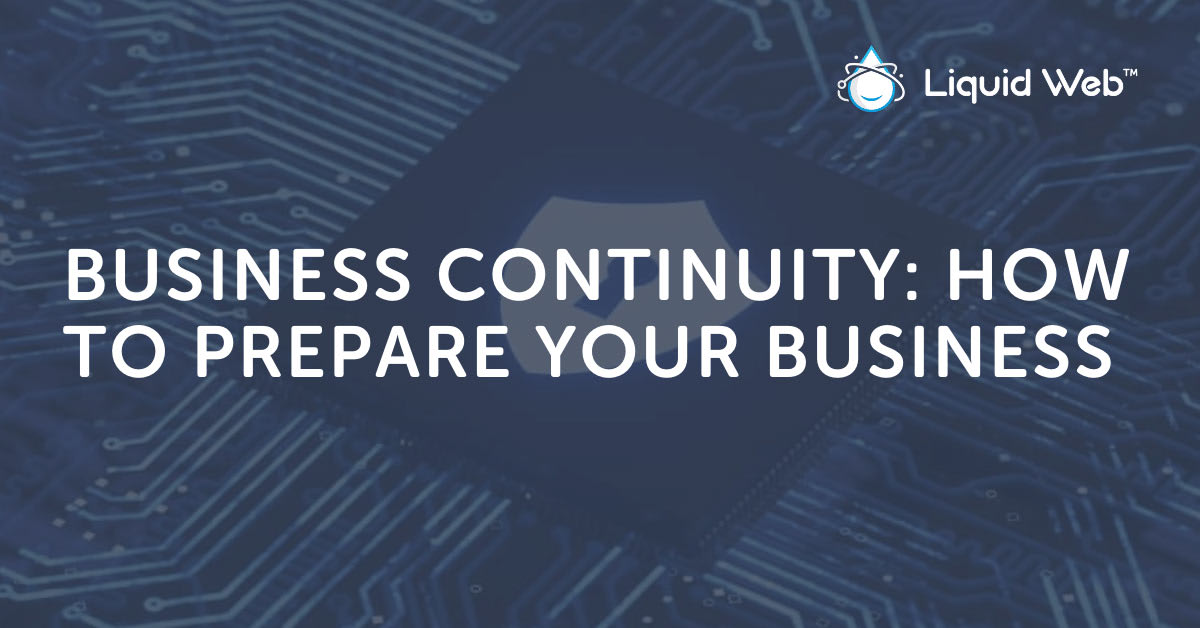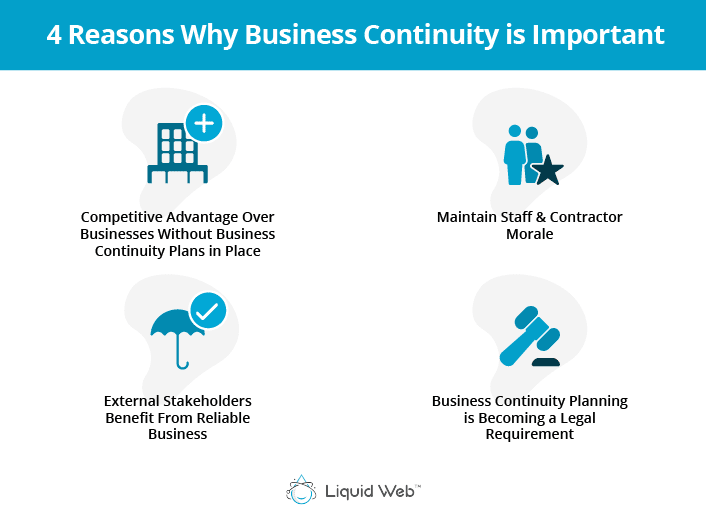
“Uncertainty is the only certainty there is…”
Business owners experience all sorts of unplanned events in a business environment, yet still have to remain functional and profitable. For an organization to maintain this type of continuity requires more than just tackling each challenge as it comes.
That kind of attitude might be able to handle smaller disruptions, but it will leave you dead in the water when major disasters occur. This is why business continuity planning and management is an essential part of any business venture.
What is Business Continuity?
Business continuity can be described as all the planning and preparations that an organization carries out in advance to ensure that it can still operate its critical business functions during a crisis. That means doing everything you can ahead of time to ensure that if things get rough, your business remains afloat and can still deliver value to customers.
And what are these problematic situations or events that business continuity is supposed to prepare your business for? Situations that negatively affect normal business operations could lead to initiating your business continuity plan, which could include:
- Power outages.
- Hardware failures.
- Natural disasters.
- Cyberattacks.
- Burglary attempts.
- Global pandemics.

Why is Business Continuity Important?
Regardless of your business’s size and scale, having a business continuity plan (BCP) is essential and goes beyond just ensuring that you and your business survive during a disaster. Business continuity is important because:
- It gives you a competitive advantage over businesses that have no such plans in place. In the case of a major disaster that affects your industry, your business will be positioned not just to survive but take advantage of opportunities that arise from others who were less prepared.
- You maintain staff and contractor morale because they know that the business is more than likely to keep operating regardless of what will happen. Thus, their livelihoods are secured to a reasonable extent.
- External stakeholders such as suppliers, subsidiaries, and business partners will also benefit from a reliable business that has plans to continue to meet its responsibilities even while going through tough times.
- Business continuity planning is quickly becoming a legal requirement due to the increasing number of businesses failing because of inadequate risk management or recovery plans.

The Five Parts of Business Continuity
Having established how important it is, you should also understand that ensuring business continuity requires having both a business continuity plan and process in place. While a business continuity plan’s specifics may vary based on several factors, five components are essential in every business continuity plan.
1. Leadership and Responsibilities
The Business Continuity Management (BCM) Team will be a small group of individuals within the organization responsible for driving the development and implementation of the process. Ideally, this team should consist of senior management staff who can make decisions and allocate the necessary resources without any roadblocks.
2. Risk Assessment
Also referred to as a Business Impact Assessment (BIA), the goal is to identify the things that are potential threats to the business. In other words, the purpose during the risk assessment is to identify which business processes will be affected by disruptions from these threats, and how badly the processes will be affected. The BIA results will serve as the basis for how the BCM team will allocate resources to ensure that operations will continue if ever these threats do occur.
3. Risk Mitigation
Once the business risks and their impacts have been identified and documented, mitigation strategies are necessary to reduce your organization’s exposure to these risks. Professionals should carry out both the risk assessment and mitigation to ensure that all possible risks are identified, and proper strategies for minimizing their impact on the business are developed and implemented.
4. Recovery and Continuity Strategies
Beyond developing risk mitigation strategies, you should also have detailed procedures for how your business will recover from disaster-type events and will continue to function. The results from the BIA are what will provide the basis for these strategies. Don’t skimp on the details while developing these strategies, as they are critical to your organization’s survival. Also, always remember that communication is a key strategy.
5. Testing, Implementation, and Continuous Improvement
Once all the necessary strategies and procedures have been developed, you won’t know how effective they are unless you carry out some testing and implementation. Testing will involve informing your team about the plan’s details and training them on their respective roles and responsibilities. Regular drills and exercises will be required for the different scenarios covered by your strategies to ensure that everyone fully understands what to do. After testing, analyzing performance and collecting feedback will help identify weak points and provide you with information that can be used to improve your plans continuously.
You should note that a business continuity plan (BCP) and a disaster recovery plan (DRP) are not the same. There is some overlap in their components, but while the primary goal of a business continuity plan is to keep your business operations running during a disaster-type event, a disaster recovery plan aims to restore your business operations and processes after a disaster has occurred. Both are essential to have in place for long-term recovery and success.

Four Things to Consider for Your First Business Continuity Plan
Size of Your Organization
While a business continuity plan is a must-have for every business, your organization’s size and scale should determine the plan’s comprehensiveness. If your business is a small-scale organization, it’s best to start with something manageable by first identifying critical business processes and developing a basic continuity strategy for each one.
A much larger organization will require a BCP that includes:
- A risk assessment matrix.
- Mitigation plans for how to deal with disasters.
- Critical business functions overview to identify those processes a business just can’t do without, and an outline of strategies for sustaining them.
- Orders for succession or delegation of duties.
These plans will be specific for each department or physical location of the business.
You can build upon your plan as your business grows. However, never think you’re too small to require a business continuity plan.
IT Infrastructure
Information Technology is a major backbone for most businesses today, so your business continuity plans will need to list the minimum hardware, software, and data requirements for business processes to continue. It will also need to cover recovery strategies for your IT infrastructure to get things back up and running in the event of a disaster.
These will probably include remote backups, work from home policies, communications strategies, and cybersecurity incident response plans.
Metrics
If you want all your planning to remain objective, you will require metrics to measure how well your business continuity plans adhere to industry standards.
The important thing to note here is that your planning should not be about an abundance of activities and strategies. Instead, it should focus on specific plans and actions that can be reliably tracked to give feedback on your progress and help drive improvement.
For example, you could develop metrics for measuring how well your business continuity program aligns with the industry standards. The results of this will determine whether you need to improve your efforts. You could also use metrics to track your staff’s knowledge of their roles in the business continuity plan to see if you need more training and scenario-based exercises or not.
Budget
While you need a sufficient budget to cover the core activities of your business continuity plan, that budget should not be so large that it hinders the rest of the organization. Factoring budget size into your planning will also help you plan smartly to make the most out of what you have.
Standards
Do not develop your business continuity plans on your own. There’s nothing to gain in trying to reinvent the wheel.
There are several globally recognized standards for business continuity that experts have developed in the field. You can rely on these as a starting point for developing your own plans.
A few you should consider are the Business Continuity Institute’s Good Practice Guidelines, the International Organization for Standardization ISO 22301, and the National Institute Standards Technology (NIST) 800.
The industry in which your business operates, and your available resources, will also play a role in determining which standards you choose to adopt, so take your time to go through the available options before you make a choice.
Business Continuity is a Journey
The information above is more than enough to get you started on your journey into business continuity.
If you’re looking for even more resources to deepen your understanding, you should check out this on-demand webinar on Business Continuity in a Pandemic.
[ad_2]
Source link


![Business Continuity [5 Steps to Create Your First Plan]](https://dealzclick.com/wp-content/uploads/2022/02/Realme-Book-Slim-Review-NDTV-Gadgets-360.jpg)
![Business Continuity [5 Steps to Create Your First Plan]](https://dealzclick.com/wp-content/uploads/2022/02/NEW-Spiritual-Niche-from-a-premier-CB-vendor.jpg)



